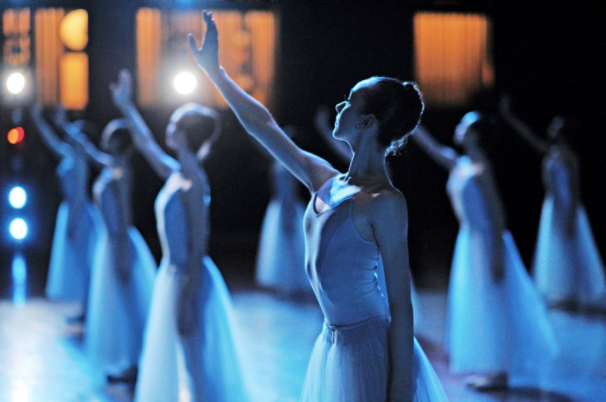
by Erika Rose Haack | Jul 6, 2021 | Coming Up, Feature, General, The Arts
SF, California. The San Francisco Ballet, in partnership with Stanford Live, announced its first in-person performance since shutting down in March 2020 in response to the COVID-19 pandemic. The performance, titled Starry Nights: SF Ballet’s Return to the Stage, will take place at the Frost Amphitheater the weekend of August 13-14. This will be the Company’s first performance at Stanford University in over 50 years. After seventeen months of virtual programming, dancers are thrilled to perform on stage. Artistic Director Helgi Tomasson says: “Starry Nights is a celebration of our dancers’ resilience and a symbol of gratitude to the community that has ushered us through this remarkable time.” Tickets go on sale July 10 at 12 PM via Stanford Live.

Core de Ballet performing a variation within the ballet “Serenade” Choreographed by George Balanchine (1935)
Established in 1933, the San Francisco Ballet is the oldest professional ballet company in the United States. By 1939, under the Company’s ballet master William Christensen, the SF Ballet performed the first full-length American production of Coppélia (1938). Its first international debut in 1957 featured performances in eleven nations across Asia and the Middle East, followed quickly by another tour to Latin America in 1958. In 1974 the SF Ballet established an extraordinary grassroots effort “Save Our Ballet” that rescued it from the brink of bankruptcy. Now, 88 years later, the Company remains one of the most preeminent ballet companies in the world.
The San Francisco Ballet was the country’s first arts organization that ceased performances in light of the burgeoning COVID-19 outbreak. Its 2021 season featured entirely virtual performances until now. The upcoming performance of Starry Nights includes George Balanchine’s Serenade (1935) and Tarantella (1964), as well as Danielle Rowe’s For Pixie (2017) to the music of Nina Simone. It will close with Helgi Tomasson’s The Fifth Season (2006) accompanied live by the San Francisco Ballet Orchestra conducted by Martin West. There will be two performances only.
From the San Francisco Ballet:
San Francisco Ballet, long recognized for pushing boundaries in dance, has a history of making history. Our mission is to share our joy of dance with the widest possible audience, both locally and around the world. Join us for our long-awaited return to live performances, featuring a thrilling blend of poetry and athleticism.
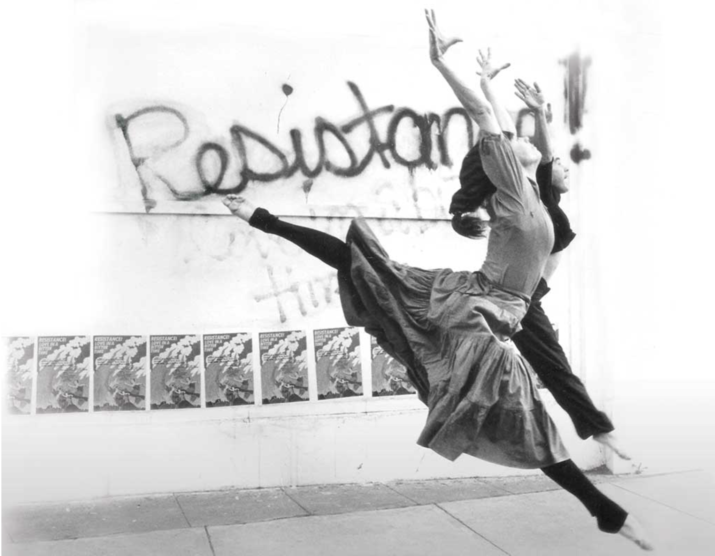
by Erika Rose Haack | Jun 22, 2021 | General, News, The Arts |
San Francisco, CA. The urgency of the moment in the wake of George Floyd was never lost on Dance Mission Theater. Founded on social change and resistance through dance performance, DMT took swift action in solidarity with the Black Lives Matter movement. Staff and board members established a Reparations Program to support dancers and artists of African descent. Krissy Keefer, Executive Director, released a statement outlining the theater’s response to the “gross inequities” laid bare by the COVID-19 pandemic. Their Reparations Program includes access to free theater space, free tuition for youth dance classes, reduced rates on rehearsal space, and half-off adult classes.
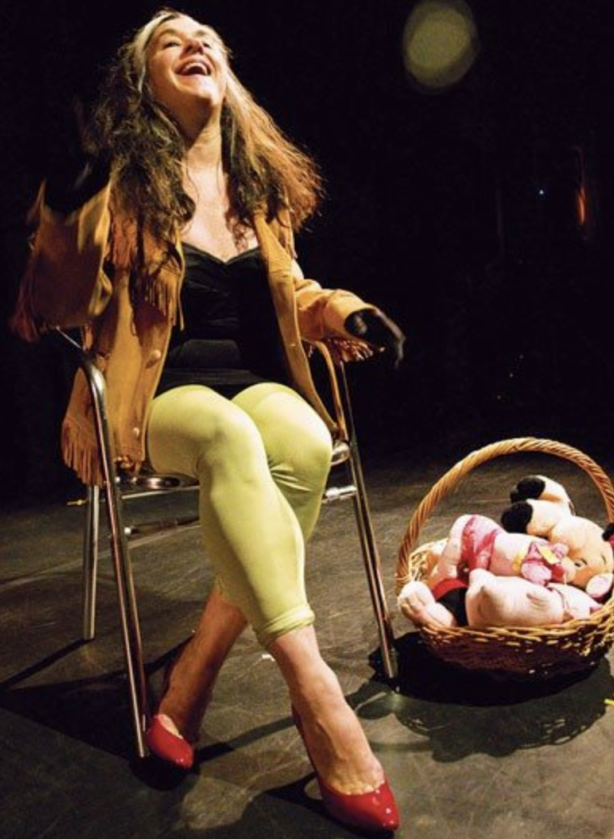
Krissy Keefer, co-founder of Dance Brigade and Executive Director of DMT. Photo from the San Francisco Examiner.
Dance Mission Theater originated in 1984 as a single feminist dance company, the Dance Brigade. The Dance Brigade spent 14 years establishing its artistic voice and community presence. In 1998 they created Dance Mission Theater, a 140-seat black box theater, and 3 dance studios located at 24th and Mission. To this day, Dance Mission Theater is a cultural hub for BIPOC, LGBTQIA+, and women artists. A flourishing inter-generational community, Dance Mission “connects and empowers [students of diverse backgrounds] through dance”. Classes and productions feature culturally rooted dance forms while exploring complex social justice issues. Dance Mission is dedicated to centering those marginalized by race, poverty, and gender in the arts. Providing accessible classes and spaces to Black students through their Reparations Program is a new step toward forwarding that goal.
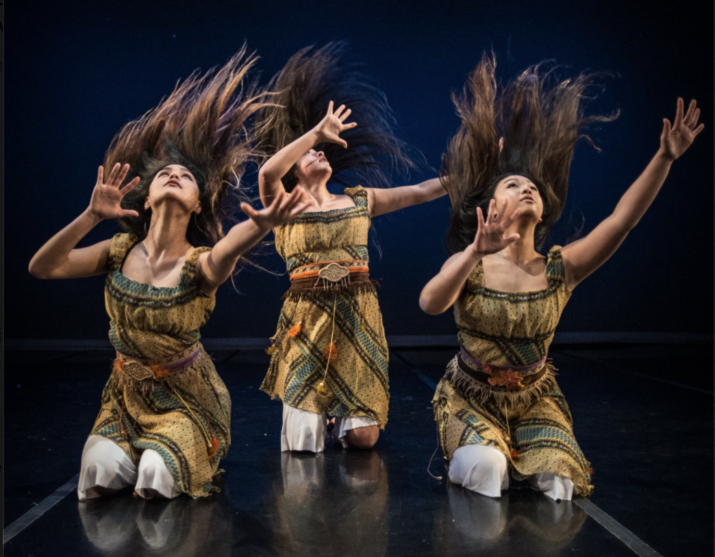
Grrrl Bridgade performs to Robbie Robertson’s song “Coyote Dance” at the Brigade’s 15th Anniversary Performance.
From Dance Mission Theater:
Dance Mission Theater operates from the understanding that the United States was founded on the genocide of Native peoples and the enslavement of African people and has neither apologized nor rectified this original wound. We are committed to programming that reflects the best efforts of who we are – BIPOC, LBGTQ+, and Children – to transform the culture of white supremacy, police brutality, and patriarchy to build a more equitable and peaceful world.
Author’s note: Ericka Hart, M.Ed. and anti-racist educator, calls attention to the fact that while Dance Mission Theater decided to term this program “Reparations” it is not actually reparations. Reparations are owed to Black people by the State because of the generations of wealth denied to the enslaved Black persons who produced them. Individual and community action separate from the State does not diminish nor replace that responsibility.
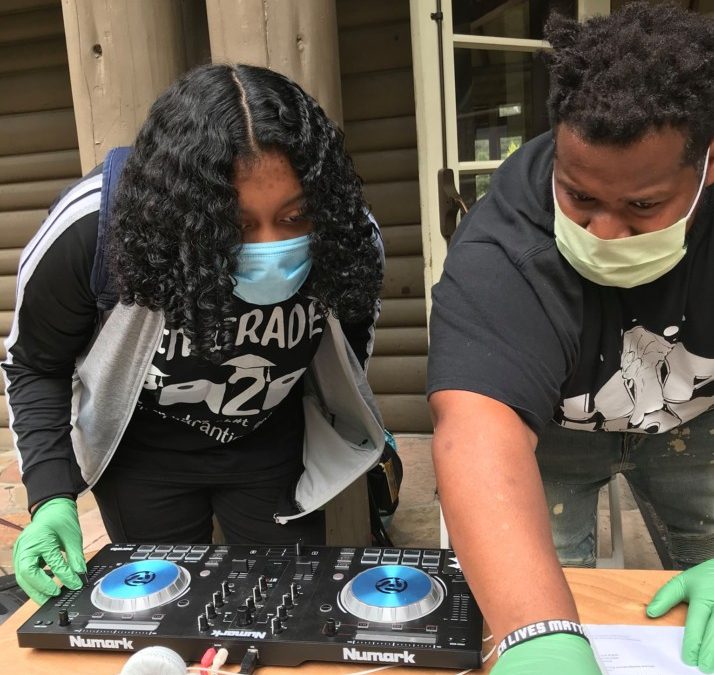
by Morgan Saltz | Aug 10, 2020 | Coming Up, General, News, The Arts
Oakland, CA. The beat goes on at Hip Hop for Change during the COVID-19 pandemic. Marlon Richardson, (above) is a Hip Hop educator who finds ways to continue working with marginalized youth and adults. While the historic Black Lives Matter (BLM) protests in the wake of George Floyd’s death are heightening awareness about racial and social injustice, artistic expression in the form of Hip Hop music has long been an outlet to critique unjust power relations. The emergence of Hip Hop culture in the 1980s impacted both social progress and individual growth. It was also the foundation for the nonprofit organization, Hip Hop for Change.
Founded in 2013, Hip Hop for Change offers programs to educate, support, and inspire both the youth and adults of Oakland. Executive Director Khafre Jay emphasizes the importance of working with urban youth who are dealing with discrimination and violence as a part of their everyday lives. Hip Hop for Change has implemented THE MC Program (Theory of Hip Hop Evolution, Music, and Culture) and has expanded the program to connect the youth to artist-educators who are trained to mentor and motivate young artists in the pursuit of their artistic aspirations. The program is not only for the youth; the artist-educators benefit from the training and employment provided by Hip Hop for Change. Khafre Jay emphasizes the impact of the program; “Since its inception, THE MC Program has touched the lives of over twenty thousand K-12 students, employed and trained dozens of local artist-educators, and half of our programming has provided for free to underserved youth. This program alone is one of the best reasons to support our organization’s work.” Not only the Executive Director for Hip Hop for Change but an established Oakland hip hop artist, the mission resonates personally for Khafre Jay; “Hip Hop is a very empowering culture. It provides an expressive space for youth of color as well as a constant pull towards self-affirmation, and ideas of self-esteem, and self-efficacy. For a lot of POC youth, the first time they find themselves experimenting with self-worth is through Hip Hop expression, and I was no different growing up.”
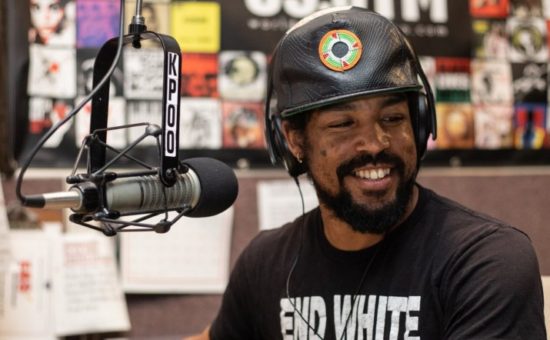
Executive Director Khafre Jay also holds a radio show on KPOO and is founded by Poor People’s Radio. The mission is to bring public news to the “disenfranchised and underserved”.
Grassroots activism has been intrinsic to Hip Hop for Change. Khafre Jay explains that “grassroots activism allows us not to have to code-switch as an organization.” He explains that a nonprofit such as his, which is Black-led and culturally focused, is not valued by the predominantly homogeneous decision-makers of white males that can provide funding. Therefore, receiving funding is difficult. However, Hip Hop for Change has had success through the Grassroots Jobs Program that not only spreads its mission statement to the community but provides employment, education, employee development, and connects their employees with community activism. As Khafre Jay explains; “Grassroots activism allows us to create hundreds of jobs and employ people in our village while engaging and informing the public about race and social justice. We couldn’t be as effective as Black and Brown people in this country without grassroots tactics.”

Employees for the Grassroots Jobs Program who are dedicated to fighting racial and social injustice
The Grassroots Jobs Program has suffered from the global pandemic as Hip Hop for Change was forced to furlough employees, and further setbacks came as school contracts ended due to COVID. Yet Hip Hop for Change continues to create ways to bolster their community. The organization is transitioning to online educational programs and creating new services such as free music production to youth under 25. In spite of the current global crisis, Hip Hop for Change is dedicated to social and racial activism, educating the youth on the history and significance of hip hop culture, providing resources for aspiring artists, and developing employment opportunities for the people of Oakland.
From HipHopForChange:
HipHopForChange seeks to address injustices of representation through education, community building, and the creation of a platform for people who identify with Hip Hop culture to express their true voices, selves, and culture. We create a space that emphasizes and encourages the root values of Hip Hop culture: peace, love, unity, and having fun.












